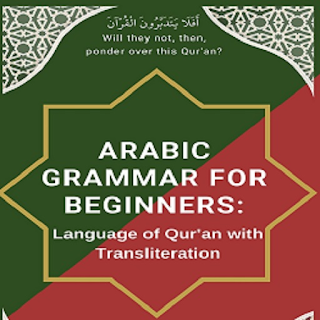Sarf and Nahw Summary: 1.1 - How to Analyze a Qur'anic Verse
All praise is for Allah SWT the Lord and Sustainer of the Worlds and peace and blessings on the leader of all messengers Mohammed and his ummah, his family, and his companions. May Allah Subhanahu wa Ta’ala guide you fully.
Section 1.1 - How to start Analyzing a Quranic Verse
It is assumed here that you have the knowledge of Arabic words and sentences and the rest of the books will give you a summary of what you need to know which includes knowledge of words and conjugations which is ilm us sarf and sentence construction which is ilm un nahw.
1. Step 1: You need to have learned how to read Arabic from a teacher to start. There is very little chance that you can learn by yourself. There are some programs like Rosetta Stone which will be very helpful.
2. Step 2: study word morphology from either:
1) From a good teacher (preferred.)
2) lectures online which is the second preferred method
3) study a good book on this subject. I have my own books which may or may not be the best for you.
a. Arabic Grammar for Beginners: Language of Qur’an with Transliteration
b. Nahw Meer: An English guide to Arabic sentences
c. Qur’an Arabic Analysis: First Fifty Ayahs
d. Qur’an Arabic Analysis: Juz 30, Surah Nabaa’ to Surah Infitaar.
All these are available on Amazon, Google, Apple, etc. They are also available as apps for Google.
You will need some help from a teacher/a native Arabic speaker/an expert in the third case.
3. Step 3:
Build your vocabulary by using the Qur’an and a dictionary online.
It will likely take 1-2 years of regular study to be able to understand 60%-70% of the word of Allah SWT.
4. Step 4: You need to practice with pen and paper as to how to analyze and understand the Qur’an.
Analysis Steps:
i) First, go through an ayah completely.
ii) Classify each word as to whether it is a noun, verb, or particle. Arabic does not have words like is, was, are, were, etc. The meaning is deduced from the construction of the sentence. Some particles provide this function of joining words (Nouns and Verbs).
I have provided several details as to how the meaning is deduced by combining the nouns, verbs, and particles in the later sections.
iii) Next, determine the following (a summary is provided later in the book):
a) If it is a noun, determine if it is definite/ indefinite نَكِرَة/مَعْرِفَة, Flexible/ inflexible مُعْرَب/مَبْنِي, Single/ Plural/ Dual واحد/ جَمْع/مُثَنَّي, and masculine/ feminine مُذَكَّر/ مُوْنَّث.
If flexible مُعْرَب, then see if you can figure out whether it is a Nominative/ Accusative/ Genitive رَفْع/ نَصْب/ جَر. Some times these obvious and sometimes the harakah on it would be due to its position مَحَلًا.
Then determine if it is making an incomplete compound (Descriptive, Demonstrative, Genitive, or Possessive which are described later). If not, then it is a sentence (Nominative اِسْمِيَةor a Verbal فِعْلِيَة). A nominative sentence will always start with a noun which is always in a Nominative state. The incomplete compounds are always a part of a sentence and can become a beginning noun المُبتَدأ or a predicate الْخبْر.
b) If it is a verb, determine if it is a Perfect Verb مَاضي, Imperfect verb مُضارِع, or a Command verb أمْر. All of these verbs will have at least one noun as an actor/subject فَاعِل, and one or more nouns which are objects مَفْعُوْلdepending upon the type of verb.
Some verbs called Transitive لَازِمneed only an actor. Other verbs called intransitive مُتَعَدّيrequire one or more objects.
Separate the parts that seem to create compounds and sentences to create meaning. Remember that compounds can become part of a sentence and can become the Beginning noun, predicate, subject, or object of the verb. Two Ayahs have been completely analyzed to show as examples in chapter 8.
5. Step 5:
You can compare your translation with Translations of the Qur’an from Ulema which are available online and in book form. This is how you will be able to catch your mistakes or the way a different interpretation is possible.
6. Step 6:
It is strongly recommended that you do not draw any conclusions on what is precise and what is allegorical and start practicing the commands and instructions. It requires a lot of studies to understand the circumstance of revelation, background, Arab culture, period, and the people for whom the revelations came. After you understand these, You will see that the verses are applicable and true for all times including today.
۞۞۞





Comments